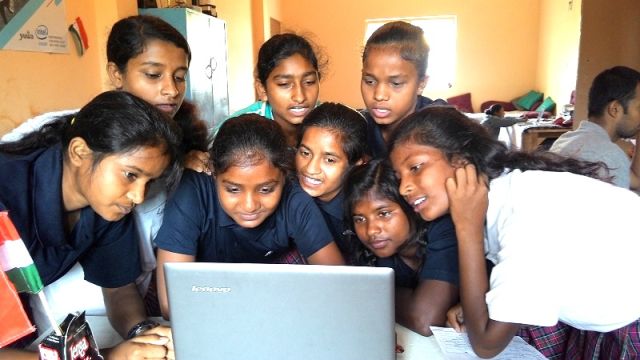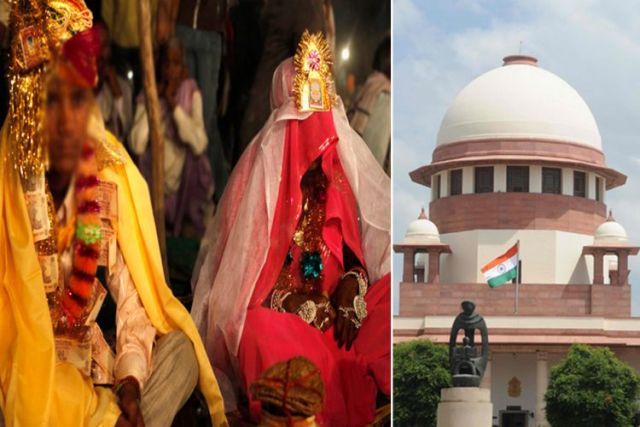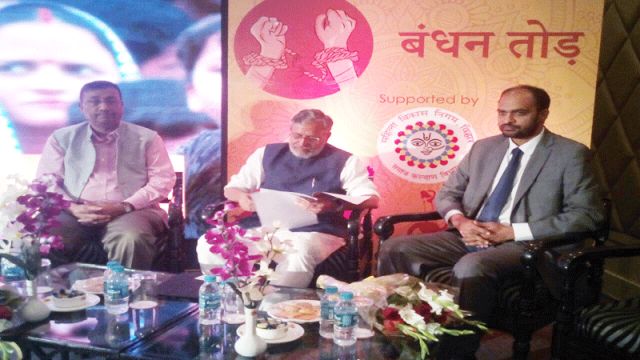
by admin | May 25, 2021 | Opinions

For representational purpose only (google image)
By Swagata Yadavar,
If a girl in India studies for 12 years or more — till the age of 18 — she is less likely to have teenage pregnancy, less likely to have shorter interval between children and less likely to have more than two children during her lifetime, according to the latest national health data.
A woman with 12 years or more of education has her first child at the median age of 24.7, which is 3.7 years more than the median age of first pregnancy (21) for women between 25-49 years, according to the National Family Health Survey, 2015-16 (NFHS-4) report.
Almost one-third or 33.6 per cent of India’s population is born of adolescent pregnancies; delaying the onset of child bearing could reduce India’s projected 2050 population of 1.7 billion by more than a quarter.
If a woman studies for 12 years or more, she has an average of 2.01 children, compared to 2.2 for all women and 3.82 for women with no education, based on the mean number of children born to women aged 45-49 — a period that marks the end of a woman’s fertility.
“Postponing first births and extending the interval between births have played a role in reducing fertility in many countries,” said the NFHS-4 report.
The total fertility rate for women — the number of children she will have in a lifetime — between 15-49 years is even lower at 1.71 for women with more than 12 years of education compared with 3.06 to women with no education and 2.2 for all women.
“Education is the best contraceptive pill,” said Poonam Muttreja, executive director, Population Foundation of India, an advocacy working on family planning.
There is enough global evidence showing that educating women can reduce the fertility rate of countries, Muttreja said. “Now, national evidence also points that educating women can be a good population control strategy.”
Only four per cent of women with 12 years or more of education have teenage pregnancies compared with eight per cent for all women and 20 per cent for women with no schooling.
Child bearing at a very young age is associated with increased risk of complications during pregnancy and childbirth and higher rates of neonatal mortality.
Children born to educated mothers have higher chances of survival; under five mortality — deaths per 1,000 live births of children under five — of children whose mothers had no schooling was 67.5 while it was less than half (26.5) for children of mothers who had more than 12 years of schooling.
A woman with more than 12 years of education waits three years (35.7 months) to have another child, compared to 31.3 months for women with no schooling.
Birth intervals of less than 24 months can harm newborns and their mothers, causing preterm births, low birth weight and death.
Only 21.5 per cent women aged 15-49 had studied for more than 12 years, compared to 29.6 per cent of men.
In 2017, only one in five adolescents — 14 to 18 years — had completed eight years of schooling and by 18, some 32 per cent females are not enrolled in schools against 28 per cent males, according to the latest Annual Survey of Education Report.
(In arrangement with IndiaSpend.org, a data-driven, non-profit, public interest journalism platform, with whom Swagata Yadavar is principal correspondent. The views expressed are those of IndiaSpend. Feedback at respond@indiaspend.org)
—IANS

by admin | May 25, 2021 | News
 New Delhi : The Supreme Court on Wednesday said sex with wife below 18 years of age is rape, striking down the provision of criminal law that permitted sex with wife aged between 15 and 18.
New Delhi : The Supreme Court on Wednesday said sex with wife below 18 years of age is rape, striking down the provision of criminal law that permitted sex with wife aged between 15 and 18.
The husband is liable to be prosecuted if the woman files a complaint within a year of the sexual act, the Supreme Court said.
The landmark order comes at a time when the apex court is already hearing petitions calling for marital rape to be declared crime and a debate over the age of consent.
The court, however, made it clear that it was not saying anything on the larger issue of marital rape even though the verdict would have a prospective affect on that.
Rape and child marriage laws of India disagree on age of consent. Section 375 of the Indian Panel says sex with a girl less than 18 is rape but it makes an exception allowing sex with wife who is 15 or above, saying it is not rape even if it is without her consent.
A bench of Justice Madan B. Lokur and Justice Deepak Gupta — in separate but concurring judgements — said the exception was “arbitrary, discriminatory and capricious”.
Justice Lokur said the exception has no rational nexus with the objective sought to be achieved by the different statutes.
Describing as artificial the distinction between minor girl and a minor girl in child marriage, Justice Lokur said it was contrary to the philosophy of many statutes like Prohibition of Child Marriage Act and Protection of Children from Sexual Offences Act.
The court also urged the Centre and the state governments to take proactive steps to discourage child marriages.
Justice Gupta said the exception carved out in Section 375 of the Indian Penal Code was violative of Article 14, ArticLe 15 and Article 21 of the Constitution.
—IANS

by admin | May 25, 2021 | Markets, News, Politics, Technology
 By Imran Khan,
By Imran Khan,
Patna : In a unique initiative, Gender Alliance Bihar, a collective effort of over 270 civil society organisations backed by the UN Population Fund, has come up with a mobile application to fight the rampant social evil of child marriage in the state.
Launched by Deputy Chief Minister Sushil Kumar Modi, the “Bandhan Tod” app will try to create awareness on resisting child marriage and will also provide round-the-clock help to adolescent girls saying no to the practice in the form of an SOS button.
The Gender Alliance is an initiative of the United Nations Population Fund (UNFPA) and was started to bring together civil societies, activists, academicians, researchers, media, and others on a common platform to advocate gender equality.
“Use of latest technology like a mobile app is probably the first of its kind in the country to fight child marriage,” Nadeem Noor, head of UNFPA in Bihar, told IANS.
He said the app offers innovative features that will give girls the confidence to stand up against marriage before they are 18, the legal marriagable age for girls in India, adding its unveiling ahead of the formal launch of the statewide campaign against child marriage by Chief Minister Nitish Kumar on Mahatma Gandhi’s birthday (October 2) was a positive development.
“If the state government includes the app in its campaign, it will help us popularise it down to the village level with the wide network of thousands of women self-help groups active in rural Bihar,” he said.
Bandhan Tod is part of Gender Alliance’s strategy to support the state government’s efforts to end child marriage and dowry.
“It is a rare effort of civil society, and the first of its kind in Bihar, to support the state government’s commitment to end child marriage and dowry,” Gender Alliance convener Swapan Mazumdar said.
The app was also lauded by N. Vijayalakshmi, Managing Director, Women Development Corporation.
It will be available on Google Play store and anyone can register on it with their details — name, age, block, district and mobile number. Mobikwik, a digital payment gateway, will provide incentive to users who download it.
If the SOS button is pressed, the registered mobile number and other details of the user will be sent to the Gender Alliance monitoring cell and civil society organisations, who will contact the user to get details and then alert the local authorities for action.
Given the socio-economic and cultural context within which child marriage takes place, the campaign will aim to directly and indirectly reach out to girls at the village and panchayat levels in all the blocks and districts of Bihar through technology.
Gender Alliance stressed on the dire need and urgency to match this commitment with coordinated strategies, action and resources to end child marriages as well as early marriages in Bihar.
It has also extended support of the hundreds of civil society organisations, that are part of the initiative, to the state government in its fight against child marriage.
“Bandhan Tod mobile app will complement the Bihar government’s campaign against child marriage,” said Prashanti Tiwary, Manager of Gender Alliance.
Since its inception last year, Gender Alliance has focused its work on gender equity. Keeping this in consideration, it has also identified child marriage as one of the four priority issues as it is not only a violation of human rights, but a grave threat to the lives, health and development of girls.
Child marriage is rampant in Bihar, particularly in rural areas, despite laws against it. It is a big social problem among Dalits, OBCs and Muslims due to lower literacy rates and other factors, including poverty.
Till a few years ago, Bihar accounted for 69 per cent of child marriages of total marriages. But the latest National Family Health Survey-4 revealed that the figure has declined in Bihar in the last 10 years due to increase of education among girls.
Gender Alliance will soon come out with a ground reality report on the adolescent girls’ social, education and health status in every block and district.
“This in-depth report is likely to provide ready-made data for the government to use for different scheme implementations to achieve its goals in a time-bound manner,” Mazumdar said.
Gender Alliance has announced the Bandhan Tod award for journalism for mainstreaming gender in media and awarded adolescent girls with Bandhan Tod champion title to recognise their brave role in the fight against child marriage.
(Imran Khan can be contacted at imran.k@ians.in)
—IANS



